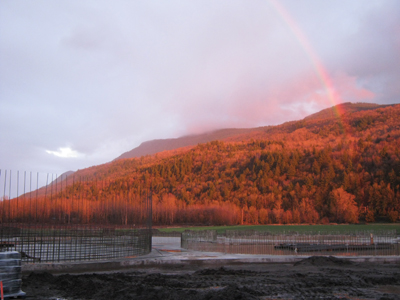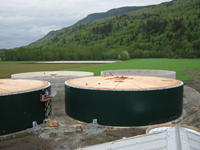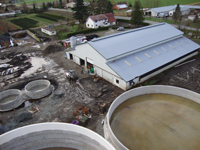
Chris Bush’s Abbotsford, B.C., dairy operation is about to become the newest source of renewable natural gas in Canada.
Chris Bush’s Abbotsford, B.C., dairy operation is about to become the newest source of renewable natural gas in Canada. For several years, the one-time construction worker and salesman has worked and lobbied hard to bring anaerobic digestion and “cow power” to farms in British Columbia. He even created and founded the company Catalyst Power Inc. to help develop the industry within the province and across Canada.
 |
|
| Not exactly a pot of gold at the end of the rainbow, but valuable nonetheless. Construction of a 1.5-acre on-farm biogas plant in Abbotsford, B.C., started in January, thanks in large part to a $1.5 million grant from the federal government.
|
Now the biogas visionary is mere weeks away from seeing all of his hard work come to fruition. At press time it was expected Bush’s $4.5 million, 1.5-acre on-farm biogas plant would begin supplying upgraded biogas to the local natural gas grid by late spring, helping to provide energy to more than 900,000 customers across the province.
“I am thrilled,” said Bush, who received a $1.5 million government grant to help fund the project.
The Abbotsford operation will be the first farm-based biogas plant located in B.C. and the first in Canada to use biogas-upgrading technology.

|
|
| Biogas made from the digesters will be upgraded to natural gas grade biomethane, with the remaining byproducts separated into liquids and solids. Bush expects to market both. |
Construction of the project’s two anaerobic digesters started in January 2010. Anaerobic digestion is a natural process that takes place in an oxygen-free environment. It involves bacteria breaking down organic wastes – such as animal manure, food wastes, cooking oils and crop residues – into biogas, also known as methane. The biogas, which is considered a clean energy source, is then captured and used to produce heat, electricity and even biofuel for vehicles.
Bush’s operation will be using dairy manure from his herd plus poultry manure, corn silage and food waste from restaurants – mainly fats, oils and greases (FOG) – as feedstock for his two digesters, each measuring 80 feet (24 meters) in diameter and 20 feet (six meters) in height. The mesophilic digester technology, which operates at a temperature of about 99 F (37 C), is being provided by PlanET Biogas Solutions based in St. Catharines, Ont.
The two main products from the anaerobic digesters will be biogas and digestate, the solid remnants left over from the anaerobic digestion process. Bush hopes to separate the digestate into solid and liquid components, using the solids as animal bedding and piping the liquid into an on-farm greenhouse and algae-growing facility.
“That way, we can get some value out of the carbon dioxide as well,” explained Sean Mezei of Greenlane Biogas, the company providing the project with the technology necessary to upgrade the biogas to natural gas quality.
Upgrading is key
When biogas is produced, it is composed of different concentrations of various chemical components, including methane, carbon dioxide, nitrogen, hydrogen, hydrogen sulfide and oxygen. In order to use the biogas as a natural gas source, it needs to be upgraded or purified. The hydrogen sulfide, which is highly corrosive to equipment, and other contaminants within the biogas need to be removed and methane concentrations increased to around 95 percent.
 |
|
| The 24-meter-diameter by six-meter-high anaerobic digesters are being supplied by Ontario-based PlanET Biogas Solutions.
|
This is where Greenlane Biogas comes in. The company provides biogas-upgrading technology that uses a water scrubbing process. The Bush farm project will be the first installation in North America to use Greenlane’s technology.
“What we’re trying to do is take that biogas and make it interchangeable with natural gas,” said Mezei. “You need to remove the carbon dioxide, remove the hydrogen sulfide and keep the oxygen and nitrogen down to a level that’s acceptable for the gas utility.”
Greenlane’s water scrubbing process works by first feeding the raw biogas into a rotary flow compressor, which compresses the gas to a higher pressure, usually around 150 pounds per square inch (psi). The compressed gas then enters the scrubbing tower, around 40 feet in height, where it is pushed up through a water media. As the gas moves through the water and up the tower, the hydrogen sulfide and carbon dioxide compounds bond with the water molecules, creating purified biogas.
“What you’re basically making is carbonated water,” said Mezei. “By the top of the tower, you have the carbon dioxide and hydrogen sulfide mostly removed.”
As added insurance, Mezei said Greenlane plans to treat the raw biogas at the Bush farm with SulfaTreat, a special process that helps to remove any remaining hydrogen sulfide via special reactant products. The biogas is mixed with the reactant within a pressurized vessel to ensure all of the hydrogen sulfide is removed.
Following removal of the carbon dioxide and hydrogen sulfide, the biogas is put through a temperature-assisted pressure swing adsorption (PSA) process, which helps to remove any remaining water plus any trace contaminants. The resulting gas is now natural gas grade and referred to as biomethane.
“Biomethane quality is critical,” explained Mezei. “If you’re not making quality, you’re not making revenue.”
Greenlane’s parent company, Flotech Services of New Zealand, has been involved in more than 30 biogas installations across Europe and Asia, including one of the largest biomethane plants in the world, located in Germany.
“The idea with our system, with the volumes that we have and the process that we have, is to maintain constant control of the methane quality,” said Mezei. “One of the key issues with trying to make these plants pay for themselves is making sure the methane purity is consistent. If you have that, you don’t have to worry about the gas utility saying you’re off spec and shutting the line and basically upsetting all the operations.”
Truly natural gas
Terasen Gas Inc., B.C.’s largest provider of natural gas, plans to purchase the biomethane produced from the Bush farm. And while there is lots of talk across Canada of using anaerobic digesters to produce power for the electricity grid, Terasen’s planning and project manager, Ken Ross, would argue the natural gas grid is the better way for farmers to go, “when it’s available.”

|
|
| The 1.5-acre biogas facility cost $4.5 million to build, using Canadian digester technology and gas upgrading technology from B.C.-based Greenlane Biogas.
|
To best use biomethane sources, Terasen has been wrestling with infrastructure limitations within its natural gas grid. After all, not all natural gas pipelines are created equal.
“The difficulty with trying to inject into a high pressure pipe is the fact that it is high pressure,” said Ross. “It’s a lot more expensive to compress the biogas enough to be able to put it into those pipelines.”
Rural pipelines can also be challenging, considering there is little demand for supply on the pipeline and additional piping may be needed to get to the source, resulting in increased costs.
Instead, Ross suggested a much better place to feed in a biomethane source would be within a lower pressure distribution pipeline, preferably near a gate station.
“You’re at a lower pressure. You’ve got lots of demand downstream so it’s a great place to put it in. The benefit of the gas grid is that it’s basically a storage grid,” he added. “You can actually store the energy there until it’s needed. We can use other gas elsewhere or hold back gas to let the biogas flow to more customers.”
Terasen became interested in biomethane several years ago and has no qualms about being the first natural gas utility to accept biomethane into its grid. According to Ross, the utility has complete faith in the biogas upgrading technologies available.
“Biogas can be cleaned to pipeline quality,” he said. “There are studies out there that indicate that it can be done. We have a level of comfort it can be done. We’re leading the way but we certainly talked to a lot of other utilities about what we’re doing. Everyone is pretty much interested in this project.”
Terasen recently surveyed the company’s 940,000-plus customers to find out how interested they would be in having access to a carbon-neutral energy source.
“Every indication shows that our customers do agree we should be working on biogas projects,” said Ross. “A smaller portion of the customers are willing to pay a higher price to get a carbon-neutral or some portion of a carbon-neutral product into their energy consumption.”
In light of this, Terasen plans to move forward with additional on-farm biogas or landfill gas projects in the near future. The utility, which controls 95 percent of the natural gas supply in B.C., has a standing appeal out to farmers and companies interested in providing biogas.
“We basically have an open door,” said Ross. “We’re getting lots of interest.”